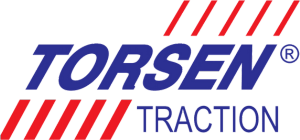Torque Bias Ratio (TBR) – also referred to as Locking Effect – is a term used to quantify how much resistance to wheel spin a differential has. This is true of any type of LSD, plate or a helical design like Torsen®. These devices work by creating internal friction; friction in the diff is what allows it resist wheel spin.
By the same token, that resistance is also what allows a differential of the non-open variety to distribute more torque to the side that can best use it. The higher the TBR setting is, the greater the resistance will be to the start of slippage. That means more torque can be sent to whichever tire has better traction. In essence, by building resistance to spin, the differential can hold back the wheel with lower traction from spinning, allowing the higher traction wheel make use of more torque.
The actual amount of friction that the differential develops will be different depending on if the internal gears are static (not moving in relation to the diff case) or if differentiation is taking place. Think of trying to push a crate across a floor – you need more force to get it to move initially than you need to keep it moving. The coefficient of friction is higher when things are not moving compared when to when they’re sliding. The same is true for the gearing in the differential.
So, there is more resistance to wheelspin when the diff gearing is not moving inside the case, which is the case when driving in a straight line. But when you turn, and one wheel speeds up while the other slows down, the differential gears want to move. Once there is enough force is on the axle shafts to overcome the friction, the gearing will start to move. In doing that, the amount of friction generated is reduced. However, this is true for clutches as well as for helical gears.
Now, that transition from static to dynamic friction is often kind of abrupt; torque gets wound into the gearing until the friction is overcome, then it pops free and moves. But when it does that, the movement slows and the coefficient goes up, and so it stops moving. At least, until the friction is again overcome and it pops free – again. In that transition, sometimes you find that stick/slip/stick/slip behavior occurs a lot. This stick/slip characteristic is also what causes clutch plates to chatter in a tradition limited slip device.
Bringing this all back around to friction modifier – the actual function of modifier (the “modification” it makes to the friction) is that it brings the static coefficient of friction down to a similar level as the dynamic coefficient of friction. This helps smooth out the transition from static to dynamic friction, getting rid of the tendency for abrupt stick/slip. This, as a result, largely eliminates the chatter or squeak . However, it does this at a price – the price of lowering the coefficient of friction for the whole system.
So, if we return to the notion that the differential is a friction device, it then stands to reason that the friction the differential generates is directly influenced by the lubricity of the oil blend that is used in the system. If the oil’s friction properties are reduced, the amount of friction that the diff produces is proportionally reduced. That, in turn, has the same affect on TBR. Usually, it is a small but measurable amount, maybe up to a 10% loss of TBR.
This begs the question of whether or not friction modifier is actually necessary in a Torsen. Like I said earlier, the modifier is beneficial in smoothing out the operations of friction devices. However, because our friction properties are different than that of a clutch plate differential, you might not see the same symptoms of stick-slip behavior that those would. As noted, clutch plate differentials have a distinct tendency to chatter without friction modifier in the oil, and that chattering can become very objectionable. So, the modifier is essentially a requirement.
In a helical gear diff, however, the stick-slip tends to show up as an audible noise, described by some as a “rusty screw” noise, or as a squeak or moan. You tend to hear it in very low-speed turns, when the steering is at or near full-lock. So, you might hear it while maneuvering in a parking lot, or turning the car around in your driveway. This noise is, as I said, just a characteristic of the friction properties, and is normal. But, if you hear it a lot and it annoys you, adding a few ounces of friction modifier to the axle lubricant will almost always eliminate it. So, the bottom line is it’s up to you.
